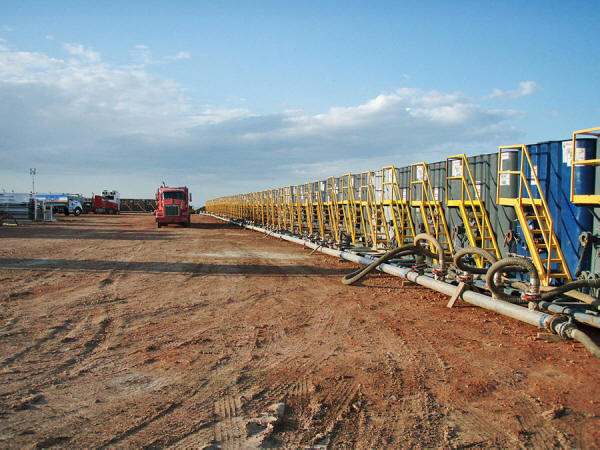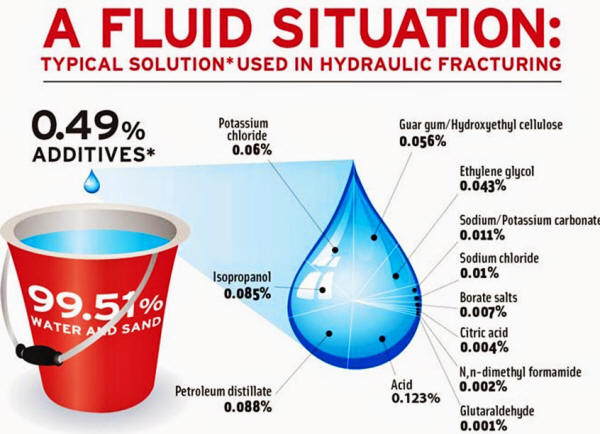1. Running Out of Gas

Not even a decade ago, government officials and industry
analysts were concerned that the U.S. could run out of gas.
That fear has passed
as a vast amount of trapped natural gas has been discovered
buried in deep rock layers. Two recent advances have made this
gas accessible:
-
hydraulic fracking, or fracturing
-
horizontal
drillings, that allow a well to be dug vertically to
turn and twist over a mile sideways through the earth
Developed over sixty years ago, fracking includes the process of
pumping millions of gallons of chemically treated water into
formations made of deep shale at a pressure of 9000 pounds per
square inch or more.
The shale is cracked
by this fluid, or existing cracks are widened, allowing the
freed hydrocarbons to flow towards the well.
Over the last
ten years, an eightfold increase has resulted because of these
advances in the production of shale gas.
Shale gas will help to
increase the output of natural gas over the next
few years, but the U.S. is nowhere near the energy reserves of
Saudi Arabia.
It can,
however, power all-natural gas devices in the U.S. for the next
twenty years or so.
Shale is an
important part of developing the national energy policy, if used
correctly.
2. Damaging Water Sources

Source: EcoNews
Obviously, the
process of
hydraulic fracturing
uses a lot of water since it can use up to seven million
gallons to frack just one well.
Of those seven
million gallons, thirty percent will be lost trapped down in the
shale. In some cases, there has been evidence that fracking
contributes to water depletion,
but in most cases of fracking, there is an adequate water system
that regulates its usage.
In some
instances, the amount of water used to frack a well is the
equivalent of drinking water used in an entire city. Fracking is
also using up water that was once used by other industries, like
that of steel manufacturing.
In comparison,
fracking uses less water daily than the mining, natural gas
development, and livestock industries.
3. Cleaner than Oil or Gasoline

Source: NorthAlisoCanyonProject
Cleaner than either gasoline or oil, burning natural gas will
emit half of the amount of carbon dioxide, a third of nitrogen
oxide, and one percent less than sulfur oxides that are released
in coal combustion.
Methane does
escape during the drilling process and when transported via
pipelines, so not all the shale gas will make it to the power
plant or fuel tank.
It is possible that the methane gas loss
could be somewhere as high as eight percent.
These leaks can be prevented by firmly sealing pipelines,
wellheads, and condensers. It is also necessary to consider that
drilling is an energy-intensive business that relies heavily on
generator and diesel engines to fully drill a well.
Lowering
emissions is a problem that will need a solution, but so far
there are few companies that have tried to address the issue.
4. Is the Groundwater Safe?

In the past, there have been surface spills that have
contaminated groundwater in fracking areas; however, the overall
fear that fracking fluids so deeply injected will gravel into
the groundwater is largely untrue.
When you look
at basic geology, you see that it isn't possible for
contamination to start underground.
The drilling
process would have to cause a fracture to spread through
thousands of feet of rock that keep deep shale gas deposits
separated from freshwater aquifers.
Layers of rock with specific mechanical properties intervene to
stop the expanding fissures from traveling toward the surface.
Plus, the
fracking fluid has been thickened with additives making it too
dense to travel upward through that type of passage.
5. Vehicles Run Cleaner on Natural
Gas

Source: LaTimes
There have been emission issues with vehicles for decades. But
that doesn't have to be the case.
Cars can be
powered by liquefied propane, natural gas, or compressed natural
gas that will run cleaner than cars that are powered by diesel
or gasoline.
By switching to
natural gas, the transportation sector would reduce
carbon-monoxide emissions in the nation by about ninety percent,
nitrogen-oxide emissions by about sixty percent and
carbon-dioxide emissions by about twenty-five percent! Very
significant numbers here!
Unfortunately, there are not enough gas stations in the country
that offer natural gas, and it would take years and billions of
dollars to create an adequate infrastructure to support it and
make it a viable option to compete with diesel and gasoline.
But considering
the trillions of dollars spent in wars each year, that's a small
price to pay in exchange for offering our children a cleaner
environment. Honda is the only car manufacturer that makes a car
that will run on natural gas.
That doesn't mean it still can't work.
There are
actually several cities that have buses that rely on it and that
incorporate a central terminal for fill-ups to circumvent the
lack of refueling places in the city.
Local truck
fleets could also follow the same formula making natural gas a
feasible option than it has been in the past.
6. Leaking Faucets

Source: GeologyLearn
There is a lasting image from a documentary that features a man
that causes a ball of fire to erupt by holding a flame to his
kitchen faucet as he turns the water on.
This image was
intended as an indictment of nearby gas drilling.
It was
determined that the gas wells were not the cause, but rather
that the water well for the home had naturally drilled into a
pocket of methane.
Up to fifty layers of natural gas can exist between the deep
shale formation and the surface.
These shallow
deposits have intruded with methane on groundwater close to
fracking sites in other places when companies have not cemented
the boreholes properly, and gas has drifted up the outside of
the well, in between the steel casing and the rock, into the
aquifers.
This is an
easy-to-correct problem by using stronger processing and cement
casing that will develop a better bond which guarantees an
impermeable seal.
7. Radioactivity

Due to a radioactive signature, drillers and geologists will
chart the huge underground formations in search of uranium
isotopes such as
radium-228 and radium-226.
When they find
higher radiation levels, they know there is a higher likelihood
that the deposits will provide a substantial amount of gas.
However, this radioactivity doesn't mean that the drilling will
cause a public health hazard, given that many homes have been
built directly on the drilling sites, long before fracking was
even developed.
Testing has
yielded no evidence that there are elevated radiation levels and
even some of the most vocal opponents to fracking have conceded
that radioactivity is not one of the biggest problems facing the
issue of fracking.
8. Chemicals in the Water

Source: FrackCity
Greater
transparency has increased under growing pressure that companies
post the
chemical compounds that they use in their well.
Often
non-threatening ingredients have been revealed including walnut
shells and instant coffee along with some known carcinogens like
methanol and benzene.
The question is
what to do when the fluid that contains these ingredients rises
back up to the surface. Certain processes are being tested, but
most companies are recycling this water to use in the next well
they plan to drill.
9. Altering the Countryside

Political opposition to fracking has been concerned that natural
gas development will change the landscape dramatically.
The fears
aren't just from the drilling itself, but the economic boom that
some areas have felt.
Development has
increased in many areas that have seen an
economic increase thanks to fracking, and residents are concerned that regulators
won't be able to keep up.
This can have a
big effect on those that want an increase in employment, but
also don't want the water quality and quality of life in the
area to deter.
10. Investing in Other Types of
Energy

With over a hundred years of natural gas now available, fracking
is going to play a big role in the development of fuel in the
future.
It is possible
that this technology can bridge the gap between polluting fossil
fuels that are being used now and the possibilities of cleaner
and renewable energy.
At the same time, the United States should continue to invest in
wind and solar energy as well as persist in conserving power and
implementing energy-efficient technology.
Natural gas can
be a transition fuel while we work on getting a larger
percentage of nuclear and renewables available on the grid.
Most people can agree that fracking is big business, especially
when you look at the areas of shale gas, and it definitely isn't
going to stop anytime soon.














